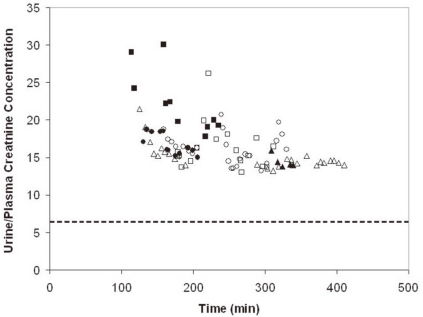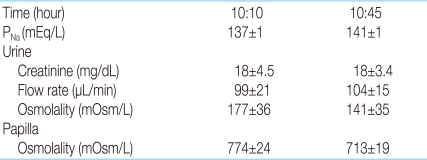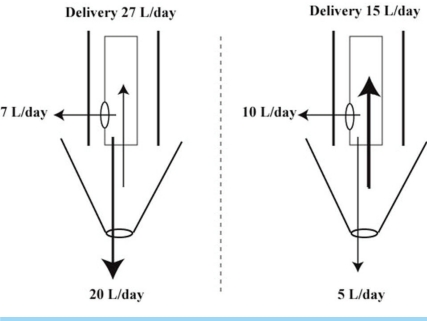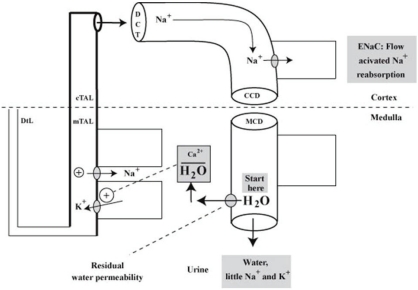Introduction
Methods
1. Animals
2. Evaluation of water reabsorption downstream from the early distal convoluted tubule during water diuresis
3. Measurement of the osmotic driving force to reabsorb water during a water diuresis
4. Analytical techniques
5. Statistical analysis
Results
 | Fig. 1Effect of a Large Water Diuresis on the (U/P)Creatinine in Rats Given a Large Oral Water Load. The (U/P)Creatinine is depicted on the y-axis and the time of collection of the urine is shown on the x-axis. The results are from 6 separate rats, as indicated by the different symbols. Once the maximum water diuresis began, the (U/P)Creatinine was virtually constant. The (U/P)Creatinine was somewhat more than 2-fold larger than 6 (the dashed horizontal line), which suggests that close to half of the distal delivery of filtrate was reabsorbed downstream for the early distal convoluted tubule, presumably from the inner medullary collecting duct via residual water permeability. |
Table 1

Table 2

The major factors that influence the reabsorption of water are the small degree of permeability of the inner medullary collecting duct (MCD) to water and the large osmotic driving force to draw water from its lumen (i.e., the difference in osmolality between the interstitial compartment and the lumen of the inner MCD multiplied by 19.3, the number of mm Hg per mOsm/L). Note that the osmotic driving force is enormous (shown in bold).
Discussion
1. Use of (U/P)Creatinine
1) Residual or basal water permeability
 | Fig. 2Contribution of Residual Water Permeability to the Excretion of Water during a Water Diuresis When the Urine Flow Rate is very High and When It Has Decreased. The structures to the left of the dashed vertical line represent a very large water diuresis and the structures to the right of the dashed vertical line represent a modest water diuresis owing to a lower distal delivery of filtrate and a larger reabsorption of water in the inner medullary collecting duct. The upper cylinder of each figure represents the inner medullary collecting duct with bolder outlines to indicate its limited capacity for it to dilate. The inverse triangular structure below it represents the renal pelvis. The arrow below represents fluid that bypasses the retrograde flow and enters the bladder. The numeric values are for illustrative purposes (see text for details). |
2) Contraction of the renal pelvis
3) Driving force
2. Physiological role of residual water permeability during water diuresis
1) The medullary thick ascending limb of the loop of Henle
 | Fig. 3Desalination of Luminal Fluid in the Medullary Thick Ascending Limb of the Loop of Henle and in the Cortical Distal Nephron. When more Na+ and Cl- are reabsorbed without water, fewer electrolytes will be excreted in a water diuresis. The stimulus begins with a high flow rate in the inner medullary collecting duct (MCD), which leads to more water reabsorption via residual water permeability (shown as a shaded oval near the 'start here' message). As a result, there is a signal (lower concentration of ionized calcium in the outer medullary interstitial compartment), which may increase the reabsorption of Na+ and Cl- in the medullary thick ascending limb of the loop of Henle (mTAL) to begin the desalination process. In the late cortical distal nephron (abbreviated as CCD), flow activation of the epithelial Na+ channels (ENaC) accelerates Na+ reabsorption. cTAL, cortical thick ascending limb; DCT, distal convoluted tubule. |




 PDF
PDF ePub
ePub Citation
Citation Print
Print


 XML Download
XML Download